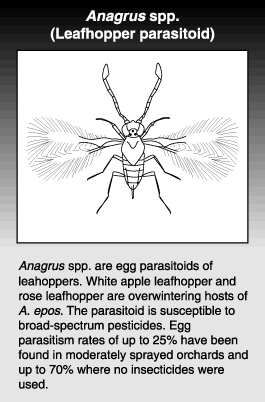by Elizabeth H. Beers, originally published 1993
(Hymenoptera: Mymaridae)
Anagrus spp. are egg parasitoids of leafhoppers and have been studied as biological control agents since the 1930s. More recently, they have been studied for their potential in biological control of white apple leafhopper in Michigan and Washington and grape leafhoppers in California. The taxonomy of this group is complex, and species identification is difficult. A. epos is presumed to be the species of interest in the West.
Hosts
Known overwintering hosts include the white apple leafhopper and the rose leafhopper. Summer hosts include grape leafhoppers (Erythroneura elegantula and E. ziczac), as well as the rose leafhopper and white apple leafhopper.
Life stages
Larva

The larva of A. epos is initially seen as an opaque, white oval shape (reported to be the fat body of the larva) inside the translucent egg of the white apple leafhopper. As it develops, the larva becomes light tan and appears segmented. Eventually it fills the entire egg chamber. Normally developing embryos of white apple leafhopper will be more opaque white, and as hatch nears, legs, abdominal segmentation and red eyes can be distinctly seen.
Pupa
In the pre-pupal stage, some light brown pigmentation appears, and segmentation becomes evident. The pupal form is a distinct, medium to dark brown. It is about 1/60 inch (0.4 mm) long and completely fills the egg chamber. During the summer generation of white apple leafhopper, the dark pigmentation in the parasitized egg can be seen through leaf tissues in which they are laid, whereas healthy white apple leafhopper eggs will be invisible at this time.
Adult
The adult is a tiny, delicate wasp about 1/50 inch (0.5 mm) long. The distinctive characters are the lack of wing veins and a fringe of hairs bordering both pairs of wings. The hind wings are small and very narrow. The antennae are long and thread-like. Color is variable but is generally dark brown.
Life history
 A. epos passes the winter as a partially grown larva inside the egg chamber of its host. This species must overwinter in a host that overwinters in the egg phase, although it can parasitize eggs of other leafhoppers during the growing season. The fat body of the larva can be seen shortly after the egg is deposited and remains in this stage until late April of the following year. Development speeds up as weather warms in the spring, and pre-pupal and pupal forms occur during late April to mid-May. Adults emerge from about May 10 to 20 to the first week in June. The emerging parasite leaves a distinctive round hole in the bark. Emergence coincides with the appearance of adult white apple leafhoppers. Eggs of the second generation of leafhoppers, which are laid in the leaf tissue, are also parasitized by A. epos. The adult leaves an exit hole in the leaf tissue when it emerges. Although adults are present from mid-May to mid-November, there are 2 or 3 peaks of activity. The first occurs about June 1; the second, smaller peak is in late July to mid-August; and a third peak is from late September through mid-October. Females deposit their eggs in the overwintering eggs of A. epos, which are inserted beneath the bark of woody host plants.
A. epos passes the winter as a partially grown larva inside the egg chamber of its host. This species must overwinter in a host that overwinters in the egg phase, although it can parasitize eggs of other leafhoppers during the growing season. The fat body of the larva can be seen shortly after the egg is deposited and remains in this stage until late April of the following year. Development speeds up as weather warms in the spring, and pre-pupal and pupal forms occur during late April to mid-May. Adults emerge from about May 10 to 20 to the first week in June. The emerging parasite leaves a distinctive round hole in the bark. Emergence coincides with the appearance of adult white apple leafhoppers. Eggs of the second generation of leafhoppers, which are laid in the leaf tissue, are also parasitized by A. epos. The adult leaves an exit hole in the leaf tissue when it emerges. Although adults are present from mid-May to mid-November, there are 2 or 3 peaks of activity. The first occurs about June 1; the second, smaller peak is in late July to mid-August; and a third peak is from late September through mid-October. Females deposit their eggs in the overwintering eggs of A. epos, which are inserted beneath the bark of woody host plants.
Monitoring
A. epos can be monitored most readily in two phases, as a larva or pupa in the overwintering eggs of leafhoppers or as an adult. To monitor larvae or pupae, the thin layer of bark overlying the leafhopper egg can be carefully cut off with a scalpel without disturbing the egg beneath. From early spring through the time the adult parasites emerge, either the larva, pre-pupa or pupa can be distinguished from a normal leafhopper embryo. The round exit hole left by the adult parasite (and at one end of the egg chamber) can be seen without dissection.
Adult parasitoids can be monitored with the same unbaited yellow sticky trap used for white apple leafhopper adults. Although this gives some idea if the parasite is in the area, it does not identify the host. Calculating the percentage of parasitism in overwintering eggs gives a more definitive assessment of biological control.
Management
Preliminary data suggest that parasitism by A. epos is adversely affected by increasing numbers of applications of broad-spectrum insecticides. Soft pesticide programs should allow this parasite to provide sufficient levels of control for the two main species of leafhoppers on apples. Parasitism levels of up to 25% have been found in moderately sprayed orchards, suggesting some tolerance to insecticides. Levels of 50 to 70% parasitism of overwintering eggs have been found in unsprayed orchards.